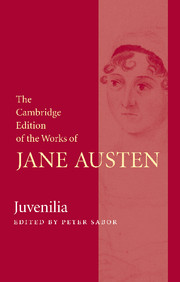Book contents
- Frontmatter
- Contents
- General editor’s preface
- Acknowledgements
- Chronology
- Introduction
- Note on the text
- Volume the First
- Volume the Second
- Volume the Third
- Corrections and emendations
- Appendix A The History of England: facsimile
- Appendix B Marginalia in Oliver Goldsmith’s The History of England, from the Earliest Times to the Death of George II
- Appendix C Marginalia in Vicesimus Knox’s Elegant Extracts . . . in Prose
- Appendix D Sophia Sentiment’s letter in The Loiterer, 28 March 1789
- Appendix E Continuations of ‘Evelyn’ and ‘Catharine’ by James Edward Austen and Anna Lefroy
- Abbreviations
- Explanatory Notes
Appendix C - Marginalia in Vicesimus Knox’s Elegant Extracts . . . in Prose
Published online by Cambridge University Press: 18 December 2020
- Frontmatter
- Contents
- General editor’s preface
- Acknowledgements
- Chronology
- Introduction
- Note on the text
- Volume the First
- Volume the Second
- Volume the Third
- Corrections and emendations
- Appendix A The History of England: facsimile
- Appendix B Marginalia in Oliver Goldsmith’s The History of England, from the Earliest Times to the Death of George II
- Appendix C Marginalia in Vicesimus Knox’s Elegant Extracts . . . in Prose
- Appendix D Sophia Sentiment’s letter in The Loiterer, 28 March 1789
- Appendix E Continuations of ‘Evelyn’ and ‘Catharine’ by James Edward Austen and Anna Lefroy
- Abbreviations
- Explanatory Notes
Summary
In her childhood, Jane Austen owned a copy of the popular anthology Elegant Extracts: or useful and entertaining Passages in Prose Selected for the Improvement of Scholars, compiled by the Christian philosopher Vicesimus Knox (1752–1821). Like its companion, Knox's Elegant Extracts from the Most Eminent British Poets, this anthology, first published in c. 1770, went through numerous editions, with later ones running to six small volumes. Austen's copy is a single-volume edition, of uncertain date. In 1801, she presented it to her then eight-year-old niece Anna, possibly on the child's birthday on 15 April. On the inside front cover, Austen inscribed her niece's full name, ‘Jane Anna Elizth. Austen’, and the date. Anna also recorded her own ownership, writing ‘1801’ beside JA's ‘1801’, and ‘the gift of her Aunt Jane’ below. The next owner, Anna's eldest daughter (1815–55), also recorded her name below her mother’s, writing, in an adult hand, ‘Anna Jemima Lefroy’. The book remained in the possession of the Lefroy family until the 1980s, when it was presented to the Jane Austen Memorial Trust; it is now on display at Jane Austen's House, Chawton.
Among the excerpts in Elegant Extracts is a passage entitled ‘The Character of Mary Queen of Scots’, taken from William Robertson’s The History of Scotland, during the reigns of Queen Mary and of King James VI (London, 2nd edn, 1759) and one entitled ‘The Character of Queen Elizabeth’, taken from David Hume's The History of England, from the Invasion of Julius Caesar to the Revolution in 1688 (London, 1763). Austen seems to have read these extracts at about the same time that she was reading Goldsmith’s History of England, in 1791, annotating them, in black ink, in a hand similar to that in her copy of Goldsmith. Her marginalia on the excerpt from Robertson concern his depiction of Mary Queen of Scots; those on the excerpt from Hume concern his depiction of Queen Elizabeth. There are also pencil notes on pages 544–5 of the volume and on the inside back cover, in a different hand from the black-ink marginalia. Since they refer to ‘Todds Johnson's dictionary’, an edition by the Reverend Henry J. Todd, first published in 1818 and popular in the early nineteenth century, they are clearly not by Austen but probably by Anna Lefroy.
- Type
- Chapter
- Information
- Juvenilia , pp. 352 - 355Publisher: Cambridge University PressPrint publication year: 2006



